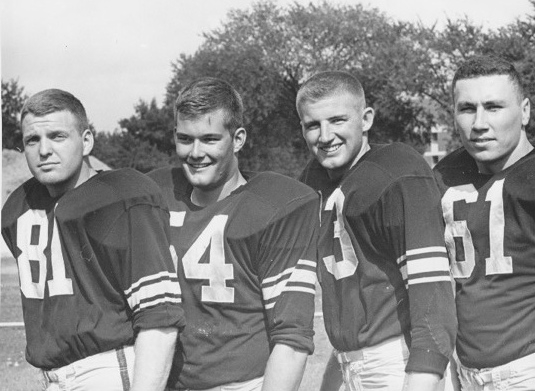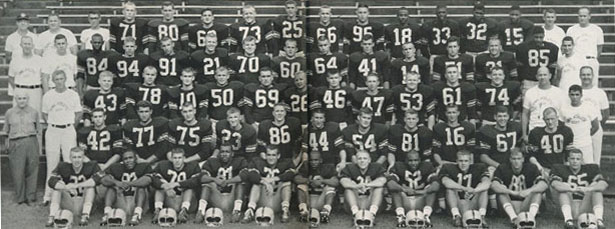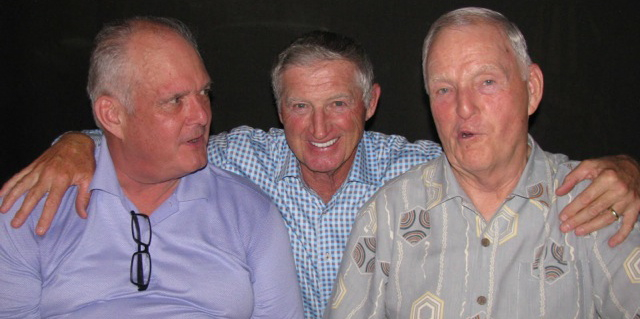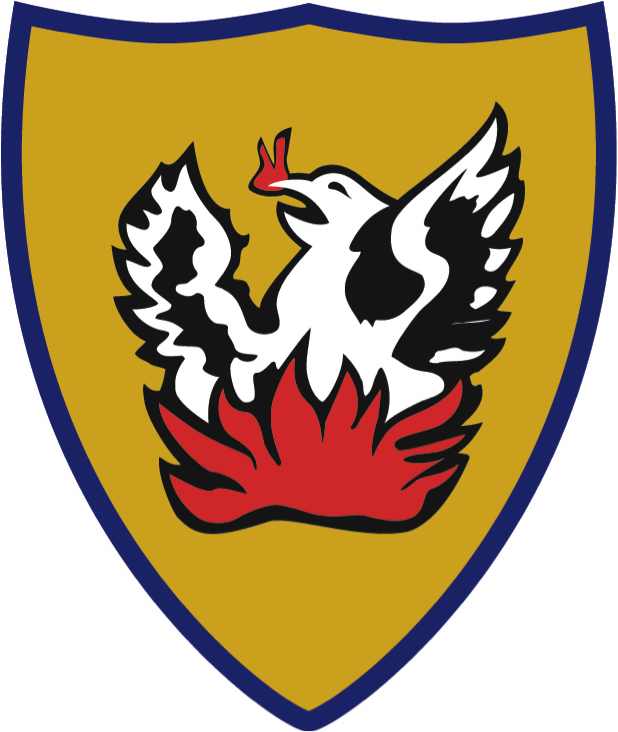Special Edition October 2013
Iowa Beta brothers among 1963 Hawkeyes
recently honored for a celebrated season
By Greg Miller (IABE ’86)
Director and Communications Chairman,
Iowa Beta Alumni Association
Members of the 1963 Iowa Hawkeyes football team, which included several Iowa Beta SAEs are celebrating their 50th anniversary The squad was honored on the field before the kickoff of this season’s first game at Kinnick Stadium on Aug. 31, 2013, whereIowa hosted Northern Illinois University.
The team also enjoyed a dinner at a restaurant in Coralville the night before where players and three of the coaches attended.They reminisced about the season where they finished 3-3-2 and boasted a strong defense.
SAE was well represented at the event as three players of the 1963 team and one of the coaches attending are members of the Iowa Beta Chapter.They joined the celebration of their Hawkeye experience so many years ago.
“We had a good team that year; should have won the conference title and gone to the Rose Bowl,” said Gary Fletcher (IABE ’65), who played position nose guard on defense and center on offense.
“I was about 220 pounds then,” said Fletcher, who played at Roosevelt High School in Des Moines. “I wouldn’t even make a good running back today.”
In those days, players lined up on both side of the ball and two-way play kept them on the field about three-fourths of the time if not more.
Besides Fletcher, other Iowa Beta football player attendees were Bob Sherman (IABE ’64) and William Niedbala (IABE ’64).
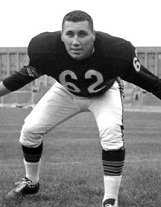
One of the Iowa Beta Hawks who did could not attend was Mike Reilly (IABE ’64), a guard from Dubuque. The team also remembered the late Carl Harris (IABE ’66), who was a reserve on the team. He died serving in Vietnam.
“Our freshman coach, Bill Happel (IABE ’58) also came,” said Fletcher. “He was a fantastic teacher and a great friend. A real True Gentleman. He also was our defensive backs coach in 1963.”
Niedbala hails from Beaver Falls, Pennsylvania.
“He was a high school teammate of Joe Namath,” said Fletcher. “When Namath was a junior, Neidbala was a senior. He was an end and played the same position on both offense and defense.”
Sherman was a running back and defensive back from Duran, Michigan. He had a couple of years playing with the Pittsburgh Steelers, being drafted in 1964. He played two seasons with them as a defensive back.
Reilly, who played linebacker on defense, was a consensus All-American along with Paul Krause and they both had successful careers in the NFL.
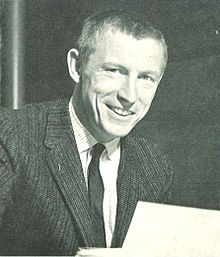
“Reilly was drafted by the Bears and was the back up to Bill George, a dominant linebacker,” Fletcher said. “The next year they draft (Dick) Butkus and he became the dominant middle linebacker for many years. For Mike, the timing couldn’t have been worse.”
After his senior year, Fletcher took a look at the Canadian football league.
“I found out there that my love of football was too closely tied to the University of Iowa,” Fletcher said. “I was a business major and I took an extra year to graduate. I served as a graduate assistant in football for a year and the next year I was the head football coach of the freshman program.”
Fletcher then went to Drake and worked as an assistant football and tennis coach. After Drake, he began his business career as a marketing executive in the savings and loan as well as trucking industries. He then went into the financial services industry. He currently serves with ING Financial Partners.
“I really wanted to be a journalism major but I couldn’t pass the typing test,” Fletcher laughed. “I just got a bunch of meat hooks and had no dexterity.”
The head coach, Jerry Burns, 86, attended the event. He served as an assistant coach for the Hawkeyes from 1954 to 1960 and as head coach from 1961-65. He was just 34 years old when Evashevski named him Iowa’s 20th head coach.
He also was head coach for the Minnesota Vikings from 1986-1991.
Another coach who attended the reunion was Jerry Hilgenberg, who oversaw guards and linebackers.
A winning tradition sets the stage for the 1963 team
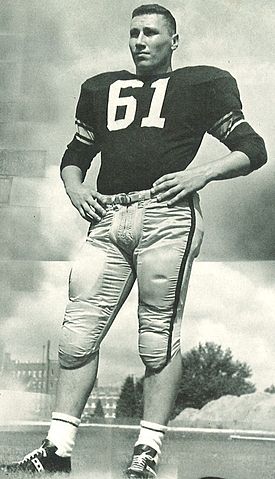
The 1963 Hawks were riding a huge crest of success when Iowa was a national football power. Coach Forrest Evashevski had resurrected a weak program in 1952 and by 1956 he got Iowa its first conference championship in 34 years and a Rose Bowl berth.
Iowa won the 1957 Rose Bowl by beating Oregon State 35-17. It was Iowa’s first postseason trip and victory in school history. Iowa almost made it back to Pasadena in 1958. A 17-13 loss to Ohio State dashed that dream. It was the Hawks’ (7-1-1) only loss of the year and they finished ranked 6th in the nation.
Evashevski returned the Hawkeyes to the Rose Bowl in 1959 after going 7-1-1. That team tied Air Force 13-13 early in the season and lost to Ohio State 38-28. The Hawks had already clinched the conference title when they lost to the Buckeyes and they ended the regular season with a 31-21 victory over Notre Dame in Iowa City.
The Hawkeyes went into the 1959 Rose Bowl ranked 2nd and favored by 18.5 points. They handily defeated California 38-12 before 98,297 people.
The Football Writers Association of America selected Iowa as the 1958 college football national champion by awarding the Hawks the 1958 Grantland Rice Award. It’s the only national championship in Iowa football history. The Hawkeyes placed No. 2 in the final AP and UPI polls,which were released before the bowl games, behind LSU. The undefeated Tigers won their bowl game, but not as impressively as Iowa.
At the end of the 1959 season, athletic director Paul Brechler said he was departing Iowa to become the commissioner of the Skyline Conference, the forerunner to the Western Athletic Conference.
“In those days, it was common for the headfootball coach to want to be the athletic director as well,” Fletcher said. “And Evy wanted to be both.”
The university administration, fearing the strain too great on his health, told Evashevski to choose just one job. He chose the AD position.
The 1960s era begins
In Evashevski’s last seasonas head coach, the Hawks won a share of the Big 10 title with Minnesota. On Nov. 5th, the top-ranked Hawkeyes fell to the No. 3 Gophers in Minneapolis 27-10. The following week, Minnesota lost to Purdue 23-14 and both teams finished 8-1.

The Gophers were chosen to represent the Big 10 in the Rose Bowl and No. 3 Iowa stayed home.
After the loss to Minnesota, Iowa closed its season by defeating Ohio State at home and Notre Dame in South Bend. In the Rose Bowl, No. 1 Minnesota lost to No. 6 Washington 17-7. The final polls came out before the bowls back then as the bowls were considered an exhibition.
In 1961 Evashevski promoted his offensive coordinator Burns to head coach.
In the late 50s and early 1960s, Iowa was really one of the top 5 teams in the country consistently,” Fletcher said. Iowa began the 1961 season ranked first in the initial AP Poll but staggered to a disappointing 5–4 record. A defeat of Notre Dame on the final game of the season gave Iowa a winning record for the year; it would be Iowa's last winning season for the next 20 years.
The 1962 team finished 4-5 but it had defeated both Ohio State and Michigan.
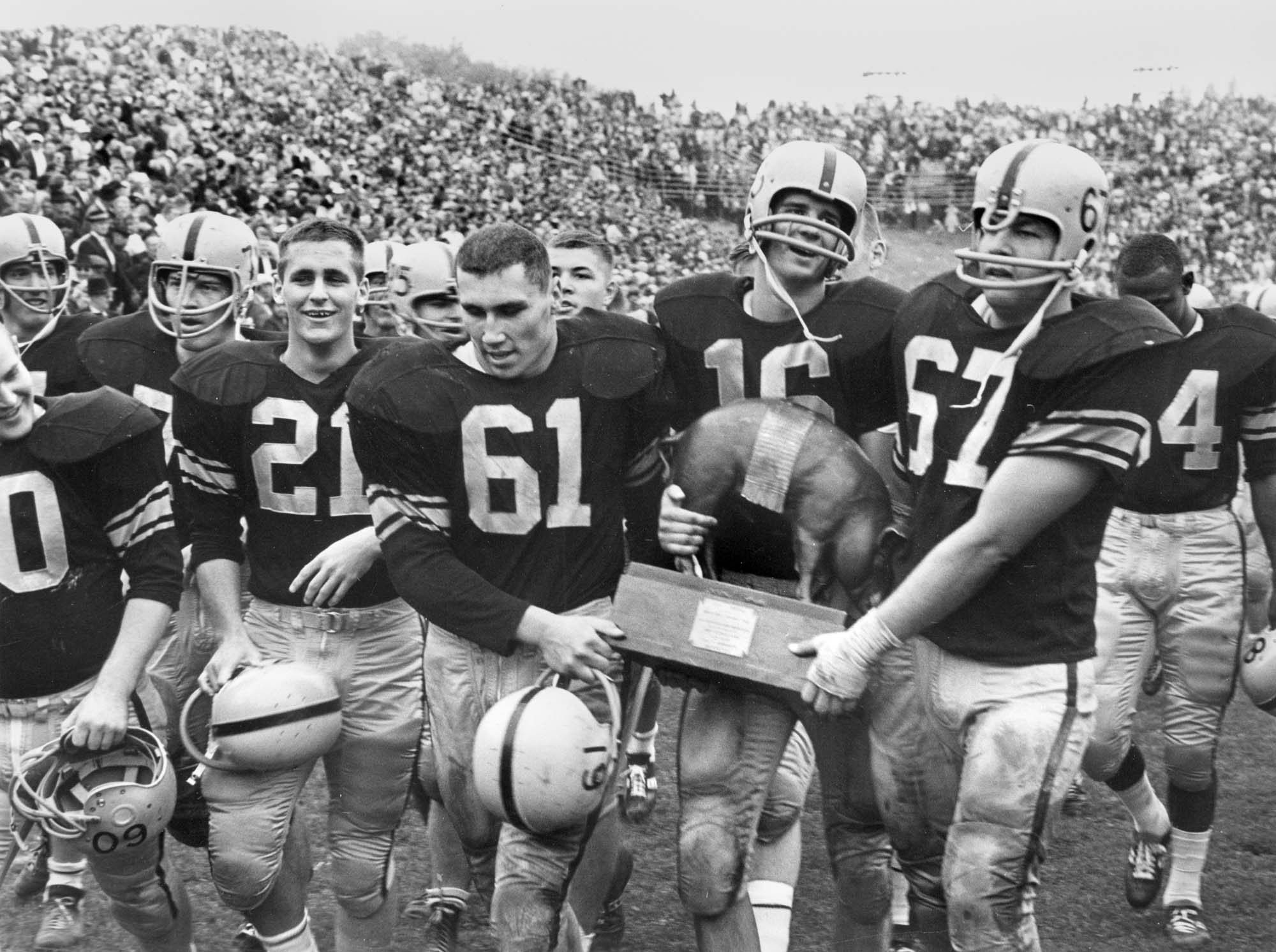
of the 1963 Iowa Hawkeye football team take Floyd of Rosedale after beating Minnesota 27-13 on Nov. 9 at Kinnick Stadium.Paul Krause, 16 and Wally Hilgenberg, 67, went on to play for the Minnesota Vikings. Mike Reilly, 61, and Richard Hendryx, 21, are members of Sigma Alpha Epsilon’s Iowa Beta chapter.
The 1963 season, a good team that made a solid run
The 1963 season started with a lot of promise. Iowa opened with a 14-14 tie to Washington State and beat Washington and Indiana in the next two games. The Hawks then suffered a 10-7 loss to Wisconsin, which let the air out of the sails.
The next two games also resulted in losses, 14-0 to Purdue and 7-3 to Ohio State. Iowa got a huge win over rival Minnesota, a 27-13 decision on Nov. 9th. The next Saturday, Iowa went into Ann Arbor and tied the Wolverines 21-21.
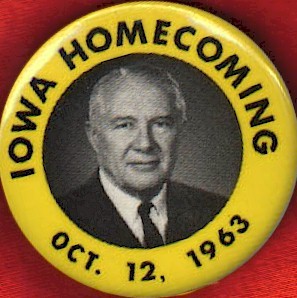
And then the world changed. On Nov. 22, theday before Iowa was to play Notre Dame, a Friday, everyone watched in horror at the unfolding ofevents in Dallas. President John F. Kennedy had been assassinated.
With the Fighting Irish in Iowa City to play football, the game never happened. Shocked by the news about President Kennedy’s motorcade, officials called off the game. About 50,000 ticket holders were offered refunds.
“We did not know the game was cancelled until about 10 o’clock Saturday morning,” said Fletcher.“Notre Dame did not want to play the game. We were told when we were ready toget on the bus (to go to the stadium) from an out-of-town hotel. “Because it has been 50 years and the fact that we could not finish out season is another reason the university decided it wanted to honor this team.”
Life as a football player, student and SAE
Freshmen were required to live in the dorms, but upper classmen could live in fraternity houses and off-campus housing.
“We didn’t have an athletic dorm,” said Fletcher. “I had pledged a fraternity as a freshman and I was a walk-on. I had gone from the seventh-string freshman center to first string in one fall. We didn’t play any games; all we did was practice.
“One of my graduate assistant coaches was Lou Holtz. He is still a buddy of mine. He was a scrawny kid from Ohio and was there to get his master’s degree in physical education and get experience from Iowa, which was one of the nation’s best football programs.
“They gave Lou all of the walk-ons, which included me, and he was very encouraging and supportive and saw that I was busting my butt.”
Fletcher’s love for the Hawkeyes started when he was about eight. His father would take him to Iowa football games.
“I really had it in my blood to be a player for this team. At mid year I had to make a decision because there were only two things I was there for, football and my education. So I gave up my freshmen pledgeship (to another fraternity) and really focused on the two things I was there to do.”
Fletcher achieved his goal of excelling at football his freshman year and was rewarded with a spot on the traveling team his sophomore year.
“I was one of just a handful of guys from my class that made that team,” he said. “So I had gotten my football career working the way I had wanted it to. But three of the guys in my freshman class were all scholarship athletes. They had succeeded as sophomores and were in the SAE house. So they came after me to join with them.”
Fletcher pledged as a junior and became part of Iowa Beta’s legacy. He said the brother most instrumental him becoming an SAE was his close friend Bob McCauley (IABE ’63), who played basketball, baseball and football.
“SAE was the center of my life as a student for sure,” Fletcher said. “I thoroughly enjoyed the brothers in the house and being a part of Iowa sports. The SAEs had a nice mix of both athletes and non-athletes. SAE was the center of my social life, which I wanted more than just being a jock. I have kept some of those relationships since the days when I was a pledge."
Fletcher plans to see some of his brothers this month at a reunion.
“I am very excited to go because some of the people attending are people I have not seen for 20 or 25 years and some I have not seen in maybe 50 years. So yeah, I am looking forward to it.”
Gary Fletcher and the brothers of 1963 are proud Hawkeyes and Iowa Beta legends.
Please join the Iowa Beta Alumni Association by updating your contact information at: www.iowabetasae.org
